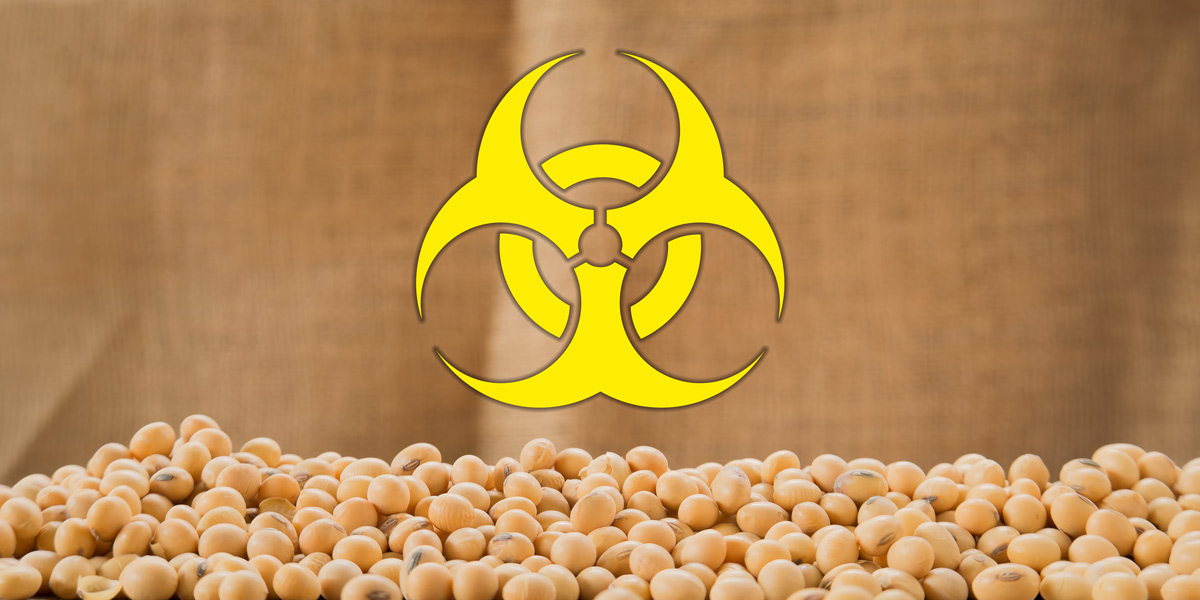
New study reveals major gaps in safety information on combined glyphosate-tolerant and insecticidal crop
A hard-hitting critique of the European Food Safety Authority’s risk assessment of Monsanto’s stacked trait GM soybeans, which are marketed under the brand name Intacta, has been published in the peer-reviewed journal Environmental Sciences Europe (see abstract below).
The paper draws attention to a major problem with the EU assessment of this and other stacked trait GM plants: the combined effects of the multiple traits – for example of the herbicides used on the crops and the Bt insecticidal toxins engineered into them – are not tested or assessed.
EFSA doesn’t require any animal feeding studies with the complete stacked trait crop. Instead feeding studies with the GM single-trait “parent” crops that were cross-bred to make the stacked crop are believed to be sufficient.
As the authors of the new paper state, “It does not make sense that stacked events showing a higher degree of complexity due to possible interactions should undergo a lower level of risk assessment than the parental plants.”
—
Possible health impacts of Bt toxins and residues from spraying with complementary herbicides in genetically engineered soybeans and risk assessment as performed by the European Food Safety Authority EFSA
Christoph Then and Andreas Bauer-Panskus
Environmental Sciences Europe
Bridging Science and Regulation at the Regional and European Level
2017 29:1
DOI: 10.1186/s12302-016-0099-0
Published: 11 January 2017
Open access: https://enveurope.springeropen.com/articles/10.1186/s12302-016-0099-0
Abstract
Background
MON89788 was the first genetically engineered soybean worldwide to express a Bt toxin. Under the brand name Intacta, Monsanto subsequently engineered a stacked trait soybean using MON89788 and MON87701 — this stacked soybean expresses an insecticidal toxin and is, in addition, tolerant to glyphosate. After undergoing risk assessment by the European Food Safety Authority (EFSA), the stacked event was authorised for import into the EU in June 2012, including for use in food and feed. This review discusses the health risks associated with Bt toxins present in these genetically engineered plants and the residues left from spraying with the complementary herbicide.
Results
We have compared the opinion published by EFSA [1] with findings from other publications in the scientific literature. It is evident that there are several issues that EFSA did not consider in detail and which will need further assessment: (1) There are potential combinatorial effects between plant components and other impact factors that might enhance toxicity. (2) It is known that Bt toxins have immunogenic properties; since soybeans naturally contain many allergens, these immunogenic properties raise specific questions. (3) Fully evaluated and reliable protocols for measuring the Bt concentration in the plants are needed, in addition to a comprehensive set of data on gene expression under varying environmental conditions. (4) Specific attention should be paid to the herbicide residues and their interaction with Bt toxins.
Conclusions
The case of the Intacta soybeans highlights several regulatory problems with Bt soybean plants in the EU. Moreover, many of the issues raised also concern other genetically engineered plants that express insecticidal proteins, or are engineered to be resistant to herbicides, or have those two types of traits combined in stacked events. It remains a matter of debate whether the standards currently applied by the risk assessor, EFSA, and the risk manager, the EU Commission, meet the standards for risk analysis defined in EU regulations such as 1829/2003 and Directive 2001/18. While this publication cannot provide a final conclusion, it allows the development of some robust hypotheses that should be investigated further before such plants can be considered to be safe for health and the environment. In general, the concept of comparative risk assessment needs some major revision. Priority should be given to developing more targeted approaches. As shown in the case of Intacta, these approaches should include: (i) systematic investigation of interactions between the plant genome and environmental stressors as well as their impact on gene expression and plant composition; (ii) detailed investigations of the toxicity of Bt toxins; (iii) assessment of combinatorial effects taking into account long-term effects and the residues from spraying with complementary herbicides; (iv) investigation into the impact on the immune and hormonal systems and (v) investigation of the impact on the intestinal microbiome after consumption. Further and in general, stacked events displaying a high degree of complexity due to possible interactions should not undergo a lower level of risk assessment than the parental plants.